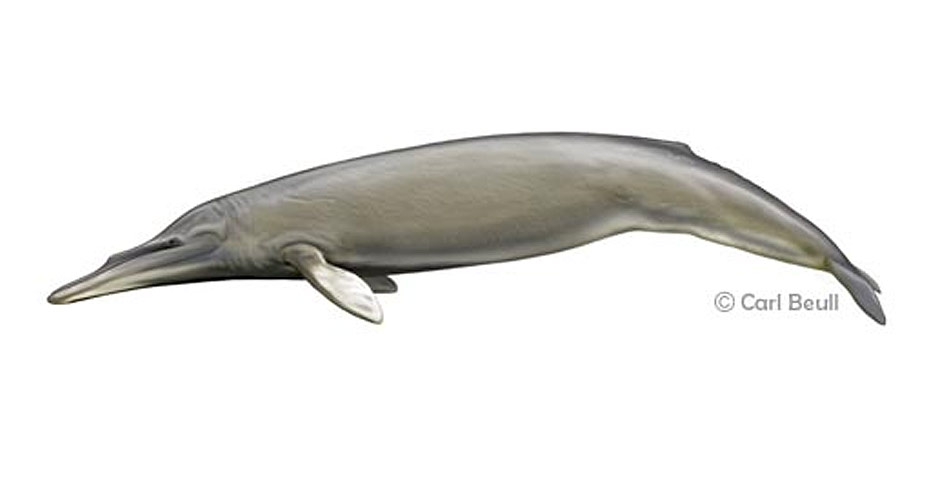
Eomysticetus Whitmorei
Age: 28 million years old, Oligocene Epoch
Range: This whale inhabited the coastal waters of South Carolina, where the only specimens have been found, and likely adjacent waters of the Southeastern United States.
Size: Although much of the skeleton of Eomysticetus is known, it is too incomplete for a length estimate. However, the skull is roughly 5 feet long, similar to the modern minke whale (Balaenoptera acutorostrata), which is on average 23 feet long.
Anatomy: At first glance, Eomysticetus would look somewhat similar to some modern baleen whales; however, there are important differences. Its blowhole is positioned well forward from its eyes, at the middle of its extremely long and narrow snout. Modern baleen whales, like all living cetaceans, have the blowhole just ahead of the eyes. The skull of Eomysticetus suggests that it had a very large temporalis muscle, one of the primary muscles that closes the mouth. Some modern baleen whales have a special elastic ligament to store the energy used in opening the mouth during feeding, which is then reused to close the lower jaw. The very large temporalis muscle may indicate that this specialization had not yet evolved and that Eomysticetus instead relied on the temporalis for jaw closure. Its earbones, unlike modern baleen whales, are only loosely attached to the rest of the skull. The flipper bones (humerus, radius, ulna) and known vertebrae of Eomysticetus are quite similar to some archaeocete cetaceans like Basilosaurus.
Locomotion: The preserved vertebrae of Eomysticetus are generally like those from the open marine basilosaurid cetaceans (archaeocetes) such as Basilosaurus and Zygorhiza. While some aspects of the flipper skeleton are similar to these earlier whales, the elbow joint allowed less movement, which suggests that the flipper had already evolved into a hydrofoil, like all modern cetaceans. Basilosaurid cetaceans and the early toothed mysticete whale Llanocetus are known to have possessed rudimentary hindlimbs that could not have supported their weight on land or assisted in aquatic locomotion. Although these bones are not preserved for Eomysticetus. we can assume that like all living whales, it used its tail flukes for propulsion.
Sensory Abilities: Because the orbits of Eomysticetus are unknown, little can be said of the vision of this animal. The lower jaw of Eomysticetus retains a very large foramen (hole) for a structure called the mandibular fat pad, which is a feature that is common in all modern toothed whales and is inferred in many archaeocete whales (such as Remingtonocetus and Basilosaurus). This indicates that like earlier fully marine archaeocete whales, Eomysticetus was able to hear underwater sounds.
Diet: Eomysticetus is one of the earliest known toothless baleen whales. Like all modern baleen whales, it lacks teeth on its upper and lower jaw, and had a wide, flat snout. It is inferred to have had racks of baleen suspended from the roof of its mouth like all living baleen whales. This suggests that Eomysticetus used a filter feeding behavior to eat large quantities of small, planktonic organisms like krill or small fish. Except for the absence of teeth, the lower jaw of Eomysticetus is similar in many ways to that of archaeocete whales like Basilosaurus. This suggests that Eomysticetus may not have had a filter feeding behavior as sophisticated as that of some modern baleen whales. For example, the lower jaw of modern balaenopterid whales (fin, sei, minke, blue, and humpback whales) is very curved and robust, which maximizes the amount of krill-laden water that can be ingested in one gulp (and the stress that the jaw can absorb). The lower jaw of Eomysticetus is gracile and straight, which implies that Eomysticetus (like many early toothless baleen whales) did not use the lunge feeding behavior of modern giants such as the blue whale.
Author: Summary written by Robert Boessenecker
References Consulted: Sanders, A.E., and L.G. Barnes. 2002. Paleontology of the Late Oligocene Ashley and Chandler Bridge Formations of South Carolina, 3: Eomysticetidae, a new family of primitive mysticetes (Mammalia: Cetacea). In R.J. Emry (ed.). Cenozoic mammals of land and sea: Tributes to the career of Clayton E. Ray. Smithsonian Contributions to Paleobiology 93:313–356.